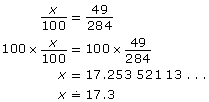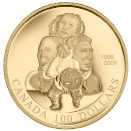Module 8
1. Module 8
1.4. Page 4
Module 8: Daily Living
Bringing Ideas Together
In Explore you compared prices using 100 g as the comparison “unit.” This means you had each item as a price per 100 g in order to determine the best price. When an item’s cost is written as a cost per unit, the cost is referred to as a unit price.
If you are calculating unit prices for items sold by weight, then the comparison unit could be 1 lb, 1 kg, 100 g, or even 1 g. The comparison unit you use depends on the context and on what gives you a reasonable answer. A price of $1.31/kg, for instance, is more understandable than a price of $0.001 31/g, although both prices are the same.
If items are sold by volume, you might use 1 L as the comparison unit, or 100 mL, or even 1 mL. And, if you were in the United States, you will see quarts and gallons used as comparison units as well.
Work through these examples.
Example 3
In Canada, prices of fruits and vegetables are often posted in the store per pound. The per-kilogram price is often on the sticker in a much smaller print size. However, if you look at your cashier’s receipt, the prices will be printed per kilogram.
At the local supermarket, bananas are advertised at $0.59/lb. Estimate the price per kilogram. Round to the nearest cent.
Solution
Remember that ![]()
1 lb costs $0.59.

Bananas cost $1.30/kg.
Mental Math
If you did not have a calculator, you could mentally calculate the price per kilogram using the approach outlined in Get Started.
First round the price to 60¢/lb. Multiply by 2.
2 × 60¢ = 120¢
Take 20% of 60¢ by finding 10% and then doubling. You know that 10% of 60¢ is 6¢. To find 20%, double 6¢, which is 12¢.

This mental estimate is 2¢ too high because you rounded up a penny and then doubled. By subtracting 2¢, you get the same answer: $1.30/kg.
 Self-Check
Self-Check
In the following questions you will convert prices between pounds and kilograms.
SC 6. Devan is flipping through a grocery flyer. He sees T-bone steak advertised for $4.99/lb.
- What is the price per kilogram?
- How would you mentally estimate the price per kilogram?
- Why do you think the price is advertised per pound rather than per kilogram?
SC 7. Penny is checking her receipt from her recent trip to the grocery store. She remarks that the chicken thighs she purchased cost $4.38/kg. What would have been the price per pound advertised at the store?
Prices per 100 mL or 100 g
Some prices are given not per kilogram or per litre but per 100 g or per 100 mL. Study the following examples to see why.
Example 4
A specialty sausage in the deli department of a local supermarket is advertised for $2.69/100 g.
- What is the price per kilogram?
- What is the price per pound?
- Give a reason why the price might be quoted in $/100 g?
Solution
- Remember, there are 1000 g in a kilogram. Since 10 × 100 g = 1000 g, a kilogram is 10 times as large as 100 g.
100 g cost $2.69. So, 1 kg costs 10 × $2.69 = $26.90.
- Remember,
 1 kg costs $26.90.
1 kg costs $26.90.

One pound costs $12.23.
- The deli uses 100 g because $2.69/100 g looks much less expensive than either $26.90/kg or $12.23/lb.
Example 5
The local supermarket displays unit prices for its canned goods, such as soups, to the nearest tenth of a cent per 100 mL. A 284-mL can of tomato soup sells for $0.49. What is the unit price the store would display on the shelf?
Solution
$0.49 = 49¢
Set up a proportion. Let x be the price per 100 mL.

The unit price label reads 17.3¢/100 mL.
In the next set of questions you will use unit prices to see which item is the better buy.
 Self-Check
Self-Check
SC 8. At the same supermarket as in Example 5, a competitor’s brand of tomato soup is sold in a 300-mL can for $0.55.
- What unit price is shown for this brand?
- Based on price alone, which brand of soup is the better buy: the soup from Example 5 or the soup in this question?
SC 9. Still at the same supermarket, Eldon is checking the unit prices to compare the same brand of breakfast cereal sold in two different sizes. The 685-g package sells for $3.29, and the 1.9-kg box sells for $9.99. Based on the unit prices shown in ¢/100 g, which is the better buy?
SC 10. A certain brand of dishwasher soap at the local general store is sold in two sizes. The 1.69-kg size retails for $5.79, and the 2.83-kg size sells for $8.49. Determine the better buy by calculating the unit price in dollars per kilogram. Round to the nearest cent.
SC 11. A popular bathroom tissue comes in two sizes: a 16-roll size that sells for $8.79, and a 24-roll size for $10.49. Calculate the price per roll to determine which is the better buy. Round the price per roll to the nearest tenth of a cent.

© 2009 Royal Canadian Mint – All Rights Reserved
 Mastering Concepts
Mastering Concepts
This is a photo of a Canadian 1-oz gold coin. The Royal Canadian Mint manufactures 1-oz gold coins for investors. The Mint also has minted gold coins with a mass of 1 kg. Precious metals are quoted in dollars per troy ounce. A troy ounce is 31.103 466 8 g.
On January 31, 2010, the price of gold was C$1156.83/oz. On that date, how much was 1 kg of gold worth?